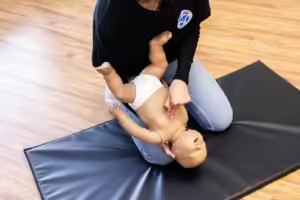
Here are some important questions to ask yourself… would you know what to do if someone went unconscious? Would you know what to do if an infant was choking? Have you ever seen an AED and wondered how it works or how to use it? Learn these things and many more when you take a CPR and AED course with a reputable OH&S approved provider in Alberta. Read through this page to learn from myself, a OH&S approved instructor trainer and a programmer for one of the largest providers in Alberta, on how to manage the CPR and AED emergencies listed above.
What To Do If Someone Goes Unconscious?
If someone goes unconscious it’s important to remain calm, survey the scene and most importantly check for dangers. Something might have harmed the victim so it’s important that you stay safe and don’t put yourself in harm’s way and also become a victim. If the victim is unconscious and not responding to physical and verbal stimuli you should send someone to contact EMS immediately. Also get someone to get an AED and someone trained to use it. Next up is CPR. I can’t teach you how to correctly do this via a blog. It’s important that you take a CPR and AED course in order to learn how to effectively do it. Physical skills are near impossible to teach only by reading and writing. This is why it’s so important that you take an in person course instead
What To Do If An Infant Starts Choking?
As a first aid instructor for a reputable OH&S approved first aid provider and a programmer, it is difficult for me to answer this question online. We typically generalize choking into two categories, partial and fully obstructed. Partial is someone coughing on an obstruction with air still uncomfortably going in and out of the lungs. Physical intervention here is not advised and coughing is encouraged. A full obstruction, when no air is passing through the airway, is much more serious than a partial obstruction. To learn the skills to manage a full obstruction I strongly encourage you to attend a in person CPR and AED course with a reputable provider in Lethbridge Alberta.
What is an AED and How Do You Use It?
An automated external defibrillator (AED) is used to help rescuers increase the chances of rescuing an unconscious victim with no breathing. The AED, which is incredibly easy to use, monitors the heart, or more specifically the SA Node, for a rhythm and shocks if it believes it will be beneficial for the victim. In other words, it will not shock the victim if he or she has a normal heart rate. AED’s can also help the rescuer’s with CPR rhythm and with direction on how to provide aid. In OH&S approved CPR and AED courses you will learn to use an AED by practising on manikins using specifically designed AED trainers.
Differences in CPR and AED training course levels
CPR Level “A” offers CPR and AED training for adult victims, including choking and bleeding injuries. CPR Level “C” offers CPR and AED training for adult, child, and infant victims, including child and infant choking emergencies. The CPR Level “HCP” offers comprehensive CPR and AED training targeted at health-care providers. CPR HCP focuses on skill training on the use of bag valve masks and rescue maneuvers on adult, child, and infant victims.
Did You Know?
Most swallowed foreign objects pass your digestive system without any trouble. However, are other times, it may get stuck in your esophagus and can damage the tissue. Make sure to remember these important tips if you notice something stuck in your throat or esophagus.
If the victim can’t breath, do:
- Five back blows. Use the heel of your hand and thump the space between the shoulder blades.
- Five abdominal thrusts. Make a fist and wrap it with your other hand. Place it just above the navel and make quick, upward, and inward thrusts.
- Repeat until object is dislodged.
Take note! If the object was pointed, head to the nearest emergency room. Attempting to remove it may cause further damage. Learn the skills of how to do this by attend a CPR and AED course with a reputable provider near you.
